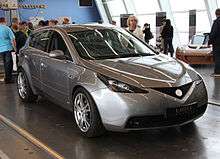Lotus APX
The Lotus APX (APX stands for Aluminium Performance Crossover) is a concept car created by the British automobile marque, Lotus. It was first introduced at the 2006 Geneva Motor Show. It is the first complete vehicle built on the new Versatile Vehicle Architecture (VVA). This vehicle is also a first for Lotus, as it is the first crossover SUV they have ever built.

Engine
The APX uses a Lotus designed and developed 3.0 liter supercharged V6 engine. The power output of this engine is 300 hp (224 kW) at 6250 rpm with a torque of 360 N⋅m (266 lb⋅ft) at 4500 rpm. It can go from 0–60 mph (97 km/h) in 5 seconds. The APX's top speed is 152 mph (245 km/h). The suspension of the APX makes it perfect for off-road use (another first for the Lotus brand) with its permanent 4 wheel drive. The combined fuel consumption is estimated to be around 8.7 L/100 km (32 mpg‑imp; 27 mpg‑US).
Also shown at the NADA 2007 show was an all-electric 4-wheel drive version of the APX, with 0–60 mph times of 4.8sec. The licensing distributor, ZAP, states it has a capacity of up to 324 wheel horsepower, up to 350-mile (563 km) range, recharge in as little as 10 minutes, and a top speed of up to 155 mph (249 km/h). They claim up to 9,000 recharge cycles and 1 penny per mile recharge costs.
Design
The APX exterior is all-aluminium. The interior features digital screens, futuristic gadgets, and many buttons.